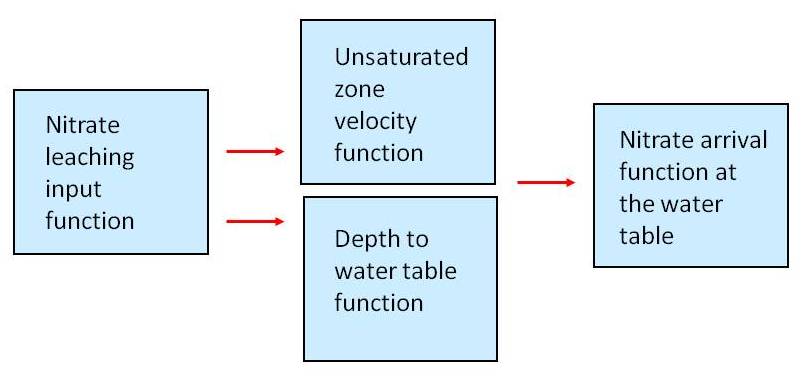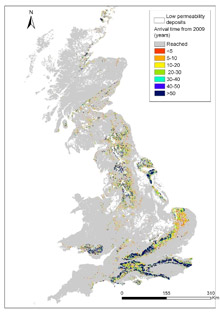Predicting the arrival of peak nitrate concentrations at the water table
BGS undertook some simple modelling to predict the time of arrival of peak nitrate concentrations at the water table on a regional scale.
The nitrate profiles in the unsaturated zone above some aquifers contain peaks of nitrate that date to times of higher inputs.
This higher nitrate water has yet to reach the saturated zone (from where it can be tapped by boreholes), meaning that nitrate concentrations in abstractions for public water supplies and other uses may continue to rise, even though changed land use practices mean that nitrate inputs have reduced. We sometimes call this the ‘nitrate time bomb’.
Modelling peak movement
The arrival of nitrate stored in the unsaturated zone has been modelled using a simple accounting procedure within a GIS.
This assumed nitrate loading from base of the soil and that movement was vertical through the matrix, without dispersion and at constant velocity:
- Nitrate leaching at the base of the soil was estimated using literature values and was compared with values calculated from pore water values back converted to time of recharge. This showed peak applications were for from the late 1970s to about 1990.
- Measured unsaturated zone velocity values were used for the Chalk, Sherwood Sandstone and Lincolnshire Limestone. For other formations these were attributed using hydromap classes subdivided on lithology.
- Depth to water was inferred from hydromap contours, point measurements or river base levels and was constrained for low permeability rocks to <10 m.
Nitrate peaks are yet to reach the saturated zone
The results showed the nitrate from peak applications has already arrived at the water table for large areas of the UK.
These include areas where the unsaturated velocity is relatively high, such as the Carboniferous and Permian limestones and the Jurassic oolites or where the unsaturated zone is relatively thin, such as the Permo-Triassic sandstones.
Thick unsaturated zone
However, significant areas which have pronounced relief and hence a thick unsaturated zone are yet to be fully impacted.
These areas include the Chalk, the Carboniferous (Fell Sandstone, Yoredales, Millstone Grit and Coal Measures), and the Scottish Old Red Sandstone.
These are shown in dark blue in Figure 2.
It will take decades for the peak to arrive over the whole UK. This delay needs to be taken into account in assessing the quality improvements from land use change.
Additional factors that would need to be incorporated to allow the prediction of future nitrate concentrations in groundwater using this model could include: soil and unsaturated zone degradation, regional estimates of unsaturated zone velocity taking account of variations in recharge, unsaturated zone dispersion, and most importantly, saturated zone thickness.
Publication
This work was reported in Wang et al., 2011. Prediction of the arrival of peak nitrate concentrations at the water table at the regional scale in Great Britain, Hydrological Processes, 25 (Wiley Online Library Early view).
Contact
Contact Dan Lapworth for further information








